MaryAnn Bernal's Blog, page 269
June 14, 2014
History Trivia - Giovanni (Juan) Borgia murdered
June 14
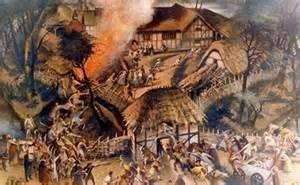
1381 The Peasant's Revolt, led by Wat Tyler, climaxed when rebels plundered and burned the Tower of London, and killed the Archbishop of Canterbury.

1497 Giovanni (Juan) Borgia, favorite son of Pope Alexander VI, was murdered, allegedly by his brother Cesare or by his younger brother Gioffre.
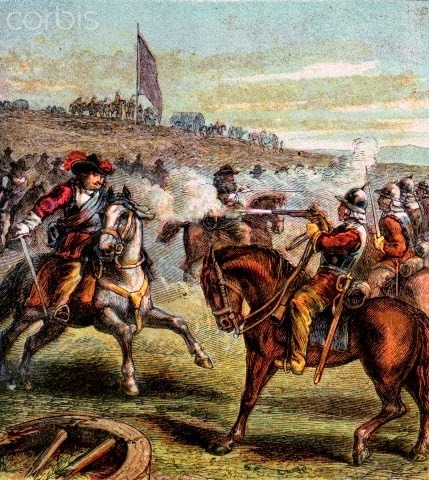 1645 Oliver Cromwell routed the Royalists at the Battle of Naseby, giving parliament victory in the civil war.
1645 Oliver Cromwell routed the Royalists at the Battle of Naseby, giving parliament victory in the civil war.


1381 The Peasant's Revolt, led by Wat Tyler, climaxed when rebels plundered and burned the Tower of London, and killed the Archbishop of Canterbury.

1497 Giovanni (Juan) Borgia, favorite son of Pope Alexander VI, was murdered, allegedly by his brother Cesare or by his younger brother Gioffre.
 1645 Oliver Cromwell routed the Royalists at the Battle of Naseby, giving parliament victory in the civil war.
1645 Oliver Cromwell routed the Royalists at the Battle of Naseby, giving parliament victory in the civil war.
Published on June 14, 2014 04:18
June 13, 2014
Diane Turner - London Rocks - 13.06.2014
Published on June 13, 2014 14:13
ONLY 9 DAYS LEFT! OVER 12,000 ENTRIES!
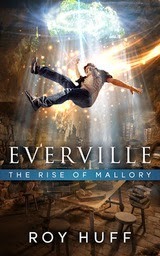
Roy Huff am running a Rafflecopter promo with a $100 Amazon giftcard and autographed copy of Everville: The Rise of Mallory as a prize to the winner. No cost to enter.
You can earn entries for free by tweeting the event, liking, pinning, inviting, donating $1 or more to either fighting pediatric aids or the National Youth Science Foundation, or simply doing a good deed.
Scroll down to the bottom of http://www.owensage.com to find the Rafflecopter for entry. Invite others to this event, or the Facebook event https://www.facebook.com/events/14167...# and earn additional entries. Giveaway contest e nds 11:59pm Pacific time June 21st.
http://www.rafflecopter.com/rafl/shar...
See who's going and get more info:
http://www.goodreads.com/event/show/930433?al=m2UWvz1tFEEoJxaTVM9wbbps3BqycT_mG1OVbfd4-nlWwM6C&utm_medium=email&utm_source=event_changed

Published on June 13, 2014 14:06
Warm or Cold? Dinosaurs Had 'In-Between' Blood
By Charles Q. Choi
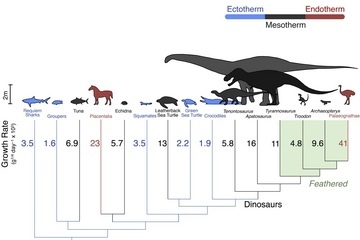
 Comparative growth rates in vertebrates. Dinosau rs grew intermediate to endothermic mammals and birds and ectothermic reptiles and fi sh, but closest to living mesotherms.
Comparative growth rates in vertebrates. Dinosau rs grew intermediate to endothermic mammals and birds and ectothermic reptiles and fi sh, but closest to living mesotherms.
Credit: John GradyDinosaurs may not have been cold-blooded like modern reptiles or warm-blooded like mammals and birds — instead, they may have dominated the planet for 135 million years with blood that ran neither hot nor cold, but was a kind of in-between that's rare nowadays, researchers say.
Modern reptiles such as lizards, snakes and turtles are cold-blooded or ectothermic, meaning their body temperatures depend on their environments. Birds and mammals, on the other hand, are warm-blooded, meaning they control their own body temperatures, attempting to keep them at a safe constant — in the case of humans, at about 98.6 degrees Fahrenheit (37 degrees Celsius).
Dinosaurs are classified as reptiles, and so for many years scientists thought the beasts were cold-blooded, with slow metabolisms that forced them to lumber across the landscape. However, birds are modern-day dinosaurs and warm-blooded, with fast metabolic rates that give them active lifestyles, raising the question of whether or not their extinct dinosaur relatives were also warm-blooded.
Animal metabolism
To help solve this decades-old mystery, researchers developed a new method for analyzing the metabolism of extinct animals. They found "dinosaurs do not fit comfortably into either the cold-blooded or warm-blooded camp — they genuinely explored a middle way," said lead study author John Grady, a theoretical ecologist at the University of New Mexico.
Scientists often seek to deduce the metabolisms of extinct animals by looking at the rates at which their bones grow. The method resembles cutting into a tree and looking at the thickness of the rings of wood within, which can reveal how well or poorly that tree grew any given year. Similarly, looking at the way bone is deposited in layers in fossils reveals how quickly or slowly that animal might have grown.
Grady and his colleagues not only looked at growth rings in fossils, but also sought to estimate their metabolic rates by looking at changes in body size as animals grew from birth to adults. The researchers looked at a broad spectrum of animals encompassing both extinct and living species, including cold- and warm-blooded creatures, as well as dinosaurs.
The scientists found growth rate to be a good indicator of metabolic rates in living animals, ranging from sharks to birds. In general, warm-blooded mammals that grow about 10 times faster than cold-blooded reptiles also metabolize about 10 times faster.
When the researchers examined how fast dinosaurs grew, they found that the animals resembled neither mammals nor modern reptiles, and were neither ectotherms nor endotherms. Instead, dinosaurs occupied a middle ground, making them so-called "mesotherms."
Modern mesotherms
Today, such energetically intermediate animals are uncommon, but they do exist. For instance, the great white shark, tuna and leatherback sea turtle are mesotherms, as is the echidna, an egg-laying mammal from Australia. Like mammals, mesotherms generate enough heat to keep their blood warmer than their environment, but like modern reptiles, they do not maintain a constant body temperature. [See Photos of Echidna and Other Bizarre Monotremes]
"For instance, tuna body temperature declines when they dive into deep, colder waters, but it always stays above the surrounding water," Grady told Live Science.
Body size may play a role in mesothermy, because larger animals can conserve heat more easily. "For instance, leatherback sea turtles are mesotherms, but smaller green sea turtles are not," Grady said. However, mesothermy does not depend just on large size. "Mako sharks are mesotherms, but whale sharks are regular ectotherms," Grady said.
Endotherms can boost their metabolisms to warm up — "for instance, we shiver when cold, which generates heat," Grady said. "Mesotherms have adaptations to conserve heat, but they do not burn fat or shiver to warm up. Unlike us, they don't boost their metabolic rate to stay warm."
Some animals are what are known as gigantotherms, meaning they are just so massive that they maintain heat even though they do not actively control their body temperature.
"Gigantotherms like crocodiles rely on basking to heat up, so they are not mesotherms," Grady said. "Gigantotherms are slower to heat up and cool down, but if they rely on external heat sources like the sun, then they are not mesotherms. In general, mesotherms produce more heat than gigantotherms and have different mechanisms for conserving it."
Advantages of being a mesotherm
Mesothermy would have permitted dinosaurs to move, grow and reproduce faster than their cold-blooded reptilian relatives, making the dinosaurs more dangerous predators and more elusive prey. This may explain why dinosaurs dominated the world until their extinction about 65 million years ago, Grady suggested.
At the same time, dinosaurs' lower metabolic rates compared to mammals allowed them to get by on less food. This may have permitted the enormous bulk that many dinosaur species attained. "For instance, it is doubtful that a lion the size of T. rex would be able to eat enough wildebeests or elephants without starving to death," Grady said. "With their lower food demands, however, a real T. rex was able to get by just fine."
All in all, Grady suspected that where direct competition occurs, warm-blooded endotherms suppress mesotherms, mesotherms suppress active but cold-blooded ectotherms, and active ectotherms suppress more lethergic sit-and-wait ectotherms
Although mesothermy appears widespread among dinosaurs, not every dinosaur was necessarily a mesotherm, Grady said. "Dinosaurs were a big and diverse bunch, and some may have been endotherms or ectotherms," he said. "In particular, feathered dinosaurs are a bit of a mystery. What do you call a metabolically intermediate animal covered in feathers? Is it like the mesothermic echidna? Or just a low-power endotherm?"
The first bird, Archaeopteryx , "was more like a regular dinosaur than any living bird," Grady said. "It grew to maturity in about two years. In contrast, a similarly sized hawk grows in about six weeks, almost 20 times faster. Despite feathers and the ability to take flight, the first birds were not the active, hot-blooded fliers their descendants came to be."
These findings could help shed light on how warm-blooded animals such as humans evolved.
"The origins of endothermy in mammals and birds are unclear," Grady said. Studying the growth rates of the ancestors of birds and mammals "will shed light on these mysterious creatures."
http://www.livescience.com/46293-dinosaurs-had-in-between-blood.html


 Comparative growth rates in vertebrates. Dinosau rs grew intermediate to endothermic mammals and birds and ectothermic reptiles and fi sh, but closest to living mesotherms.
Comparative growth rates in vertebrates. Dinosau rs grew intermediate to endothermic mammals and birds and ectothermic reptiles and fi sh, but closest to living mesotherms. Credit: John GradyDinosaurs may not have been cold-blooded like modern reptiles or warm-blooded like mammals and birds — instead, they may have dominated the planet for 135 million years with blood that ran neither hot nor cold, but was a kind of in-between that's rare nowadays, researchers say.
Modern reptiles such as lizards, snakes and turtles are cold-blooded or ectothermic, meaning their body temperatures depend on their environments. Birds and mammals, on the other hand, are warm-blooded, meaning they control their own body temperatures, attempting to keep them at a safe constant — in the case of humans, at about 98.6 degrees Fahrenheit (37 degrees Celsius).
Dinosaurs are classified as reptiles, and so for many years scientists thought the beasts were cold-blooded, with slow metabolisms that forced them to lumber across the landscape. However, birds are modern-day dinosaurs and warm-blooded, with fast metabolic rates that give them active lifestyles, raising the question of whether or not their extinct dinosaur relatives were also warm-blooded.
Animal metabolism
To help solve this decades-old mystery, researchers developed a new method for analyzing the metabolism of extinct animals. They found "dinosaurs do not fit comfortably into either the cold-blooded or warm-blooded camp — they genuinely explored a middle way," said lead study author John Grady, a theoretical ecologist at the University of New Mexico.
Scientists often seek to deduce the metabolisms of extinct animals by looking at the rates at which their bones grow. The method resembles cutting into a tree and looking at the thickness of the rings of wood within, which can reveal how well or poorly that tree grew any given year. Similarly, looking at the way bone is deposited in layers in fossils reveals how quickly or slowly that animal might have grown.
Grady and his colleagues not only looked at growth rings in fossils, but also sought to estimate their metabolic rates by looking at changes in body size as animals grew from birth to adults. The researchers looked at a broad spectrum of animals encompassing both extinct and living species, including cold- and warm-blooded creatures, as well as dinosaurs.
The scientists found growth rate to be a good indicator of metabolic rates in living animals, ranging from sharks to birds. In general, warm-blooded mammals that grow about 10 times faster than cold-blooded reptiles also metabolize about 10 times faster.
When the researchers examined how fast dinosaurs grew, they found that the animals resembled neither mammals nor modern reptiles, and were neither ectotherms nor endotherms. Instead, dinosaurs occupied a middle ground, making them so-called "mesotherms."
Modern mesotherms
Today, such energetically intermediate animals are uncommon, but they do exist. For instance, the great white shark, tuna and leatherback sea turtle are mesotherms, as is the echidna, an egg-laying mammal from Australia. Like mammals, mesotherms generate enough heat to keep their blood warmer than their environment, but like modern reptiles, they do not maintain a constant body temperature. [See Photos of Echidna and Other Bizarre Monotremes]
"For instance, tuna body temperature declines when they dive into deep, colder waters, but it always stays above the surrounding water," Grady told Live Science.
Body size may play a role in mesothermy, because larger animals can conserve heat more easily. "For instance, leatherback sea turtles are mesotherms, but smaller green sea turtles are not," Grady said. However, mesothermy does not depend just on large size. "Mako sharks are mesotherms, but whale sharks are regular ectotherms," Grady said.
Endotherms can boost their metabolisms to warm up — "for instance, we shiver when cold, which generates heat," Grady said. "Mesotherms have adaptations to conserve heat, but they do not burn fat or shiver to warm up. Unlike us, they don't boost their metabolic rate to stay warm."
Some animals are what are known as gigantotherms, meaning they are just so massive that they maintain heat even though they do not actively control their body temperature.
"Gigantotherms like crocodiles rely on basking to heat up, so they are not mesotherms," Grady said. "Gigantotherms are slower to heat up and cool down, but if they rely on external heat sources like the sun, then they are not mesotherms. In general, mesotherms produce more heat than gigantotherms and have different mechanisms for conserving it."
Advantages of being a mesotherm
Mesothermy would have permitted dinosaurs to move, grow and reproduce faster than their cold-blooded reptilian relatives, making the dinosaurs more dangerous predators and more elusive prey. This may explain why dinosaurs dominated the world until their extinction about 65 million years ago, Grady suggested.
At the same time, dinosaurs' lower metabolic rates compared to mammals allowed them to get by on less food. This may have permitted the enormous bulk that many dinosaur species attained. "For instance, it is doubtful that a lion the size of T. rex would be able to eat enough wildebeests or elephants without starving to death," Grady said. "With their lower food demands, however, a real T. rex was able to get by just fine."
All in all, Grady suspected that where direct competition occurs, warm-blooded endotherms suppress mesotherms, mesotherms suppress active but cold-blooded ectotherms, and active ectotherms suppress more lethergic sit-and-wait ectotherms
Although mesothermy appears widespread among dinosaurs, not every dinosaur was necessarily a mesotherm, Grady said. "Dinosaurs were a big and diverse bunch, and some may have been endotherms or ectotherms," he said. "In particular, feathered dinosaurs are a bit of a mystery. What do you call a metabolically intermediate animal covered in feathers? Is it like the mesothermic echidna? Or just a low-power endotherm?"
The first bird, Archaeopteryx , "was more like a regular dinosaur than any living bird," Grady said. "It grew to maturity in about two years. In contrast, a similarly sized hawk grows in about six weeks, almost 20 times faster. Despite feathers and the ability to take flight, the first birds were not the active, hot-blooded fliers their descendants came to be."
These findings could help shed light on how warm-blooded animals such as humans evolved.
"The origins of endothermy in mammals and birds are unclear," Grady said. Studying the growth rates of the ancestors of birds and mammals "will shed light on these mysterious creatures."
http://www.livescience.com/46293-dinosaurs-had-in-between-blood.html

Published on June 13, 2014 14:01
Great North Museum needs to raise £7,000 to safeguard Lindisfarne Hoard
Collection of gold and silver coins dating from 1560s was found in the same building as those found 50 years ago on Northumberland island
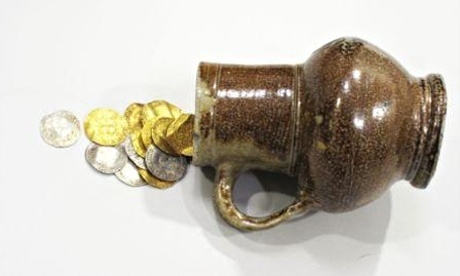 A dirty old jug with some glistening contents: the Lindsifarne Hoard. n the 1560s Lindisfarne, a tidal island off the Northumberland coast near Berwick, was something of an armed camp close to the front line of the defence against Scotland. After Henry VIII dissolved the monasteries, stones from Lindisfarne Priory were used to build a small castle and other fortifications for the harbour.So the garrison seems an unlikely place for not one but two of Britain's greatest treasure discoveries. Perhaps an officer stationed on Lindisfarne was careless, forgetful or unlucky, as two small hoards of coins dating from shortly after the castle was built in 1550 have been found near a watercourse by the same house.
A dirty old jug with some glistening contents: the Lindsifarne Hoard. n the 1560s Lindisfarne, a tidal island off the Northumberland coast near Berwick, was something of an armed camp close to the front line of the defence against Scotland. After Henry VIII dissolved the monasteries, stones from Lindisfarne Priory were used to build a small castle and other fortifications for the harbour.So the garrison seems an unlikely place for not one but two of Britain's greatest treasure discoveries. Perhaps an officer stationed on Lindisfarne was careless, forgetful or unlucky, as two small hoards of coins dating from shortly after the castle was built in 1550 have been found near a watercourse by the same house.
The first collection came to light in 1962, and consists of 50 silver 16th-century English and Scottish coins. It now belongs to the Society of Antiquaries of Newcastle, and is housed in the Great North Museum.
In 2002, while working underpinning foundations to the same house, local builder Rob Mason unearthed a dirty old jug. He kept it in his garage for several years before deciding to clean it out, when he discovered that it was filled with 10 gold and seven silver coins. The collection was taken to Dr Rob Collins, a Portable Antiquities Scheme expert in the North East who said:
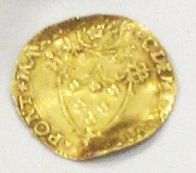 Medici gold: the papal escudo of Clement VII. The 17 coins date from around 1430 to 1562. English coins from the reigns of Henry VI and all the Tudor monarchs are in the find. It is the foreign coins, however, which make the collection particularly important. They include two gold écus from François I of France, a gold scudo from Pope Clement VII, a gold crown from the Emperor Charles V and a silver thaler (the predecessor of the dollar) from the Electorate of Saxony.
Medici gold: the papal escudo of Clement VII. The 17 coins date from around 1430 to 1562. English coins from the reigns of Henry VI and all the Tudor monarchs are in the find. It is the foreign coins, however, which make the collection particularly important. They include two gold écus from François I of France, a gold scudo from Pope Clement VII, a gold crown from the Emperor Charles V and a silver thaler (the predecessor of the dollar) from the Electorate of Saxony.
The gold papal scudo is especially rare: it was struck for Clement VII, a nephew of Lorenzo il magnifico de Medici, at around the time he was refusing to allow Henry VIII to divorce Catherine of Aragon.
Inflation has done little to erode or enhance the value of the hoard. According to Dr Collins, back in 1562, it would have had roughly the purchasing power of £30,000 today:

 A dirty old jug with some glistening contents: the Lindsifarne Hoard. n the 1560s Lindisfarne, a tidal island off the Northumberland coast near Berwick, was something of an armed camp close to the front line of the defence against Scotland. After Henry VIII dissolved the monasteries, stones from Lindisfarne Priory were used to build a small castle and other fortifications for the harbour.So the garrison seems an unlikely place for not one but two of Britain's greatest treasure discoveries. Perhaps an officer stationed on Lindisfarne was careless, forgetful or unlucky, as two small hoards of coins dating from shortly after the castle was built in 1550 have been found near a watercourse by the same house.
A dirty old jug with some glistening contents: the Lindsifarne Hoard. n the 1560s Lindisfarne, a tidal island off the Northumberland coast near Berwick, was something of an armed camp close to the front line of the defence against Scotland. After Henry VIII dissolved the monasteries, stones from Lindisfarne Priory were used to build a small castle and other fortifications for the harbour.So the garrison seems an unlikely place for not one but two of Britain's greatest treasure discoveries. Perhaps an officer stationed on Lindisfarne was careless, forgetful or unlucky, as two small hoards of coins dating from shortly after the castle was built in 1550 have been found near a watercourse by the same house.The first collection came to light in 1962, and consists of 50 silver 16th-century English and Scottish coins. It now belongs to the Society of Antiquaries of Newcastle, and is housed in the Great North Museum.
In 2002, while working underpinning foundations to the same house, local builder Rob Mason unearthed a dirty old jug. He kept it in his garage for several years before deciding to clean it out, when he discovered that it was filled with 10 gold and seven silver coins. The collection was taken to Dr Rob Collins, a Portable Antiquities Scheme expert in the North East who said:
This is a remarkable discovery and in light of the recent success of the return of the Lindisfarne Gospels to the region it would be very sad to see this treasure leave the North East.The hoard has been declared Treasure Trove, and the Society of Antiquaries of Newcastle has now launched an appeal to keep the latest Lindisfarne Hoard with its predecessor at the Great North Museum. The total price of the hoard is £30,900, with £7,000 needed from public donations.
 Medici gold: the papal escudo of Clement VII. The 17 coins date from around 1430 to 1562. English coins from the reigns of Henry VI and all the Tudor monarchs are in the find. It is the foreign coins, however, which make the collection particularly important. They include two gold écus from François I of France, a gold scudo from Pope Clement VII, a gold crown from the Emperor Charles V and a silver thaler (the predecessor of the dollar) from the Electorate of Saxony.
Medici gold: the papal escudo of Clement VII. The 17 coins date from around 1430 to 1562. English coins from the reigns of Henry VI and all the Tudor monarchs are in the find. It is the foreign coins, however, which make the collection particularly important. They include two gold écus from François I of France, a gold scudo from Pope Clement VII, a gold crown from the Emperor Charles V and a silver thaler (the predecessor of the dollar) from the Electorate of Saxony.The gold papal scudo is especially rare: it was struck for Clement VII, a nephew of Lorenzo il magnifico de Medici, at around the time he was refusing to allow Henry VIII to divorce Catherine of Aragon.
Inflation has done little to erode or enhance the value of the hoard. According to Dr Collins, back in 1562, it would have had roughly the purchasing power of £30,000 today:
Some of the coins have actually gone down in purchasing power, but the Clement VII escudo, which is one of only three I'm aware of in the world, has enormous rarity value.Collins believes the two hoards probably belonged to the same officer, with the earlier hoard acting as a domestic savings fund, and the more recent one as his international account. Both hoards were found in similar stoneware jugs made in the Rhineland. The Society of Antiquaries of Newcastle's chair, Lindsay Allason-Jones, said:
As Lindisfarne in the Elizabethan period was used largely as a military garrison, with the priory used as a supply base, it is possible that the original owner of the two hoards was a military officer who had seen service on the continenthttp://www.theguardian.com/uk-news/the-northerner/2014/jun/13/lindisfarne-hoard-gold-silver-coins-great-north-museum

Published on June 13, 2014 13:54
423-Million-Year-Old Fish Was Once Earth's Largest Vertebrate
By Tia Ghose,
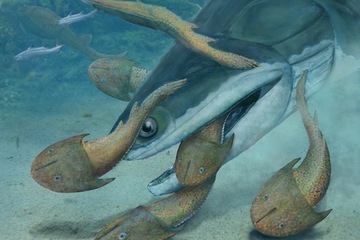
 In the sea of the Late Silurian, the Megamastax amblyodus consumes the jawless armored fish Dunyu longiforus
In the sea of the Late Silurian, the Megamastax amblyodus consumes the jawless armored fish Dunyu longiforus
Credit: Brian Choo
Scientists have unearthed a fossilized fish that was once the biggest vertebrate of its day.
The predatory sea creature, dubbed Megamastax amblyodus, which means "big mouth, blunt teeth," prowled the oceans about 423 million years ago and used its flat teeth for crushing the shells of its slow-moving, hard-shelled prey.
The new species ruled the seas during a period known as the Devonian, or the Age of Fish, which occurred between 416 million and 358 million years ago. The Devonian period saw the rise of some of Earth's largest vertebrate predators, including the terrifying Dunkleosteus, a massive predatory fish that could grow to be 33 feet (10 meters) long. [T. rex of the Seas: A Mosasaur Gallery]
But most of the fossil vertebrates unearthed from the early Devonian, or what's known as the Silurian period, were relatively small, with the largest uncovered fossil being just 14 inches (35 centimeters) long.
Some climate models have suggested that the period was characterized by low atmospheric oxygen levels, or hypoxia. Existing "marine fishes in general are also known to be less tolerant of hypoxic conditions than many marine invertebrates," the researchers wrote in the study. "This suggests that low oxygen levels would have imposed some degree of extrinsic constraint on the maximum body size and available niche opportunities of the earliest gnathostomes," or jawed vertebrates.
Big fish
Vertebrate paleontologist Brian Choo and his colleagues at the Chinese Academy of Sciences unearthed jaw and tooth fragments from the fossilized fish in the Kuanti formation in China.
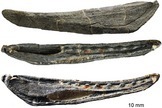
[image error] The Megamastax lower jaw.
The Megamastax lower jaw.
Credit: Min Zhu
View full size imageThe jaw was at least 6.7 inches (17 cm) long and contained both sharp conical teeth and blunt teeth. The blunt choppers would have been perfect for crushing hard shells, while the sharp teeth would have been better for grasping unsuspecting prey. The predatory sea creature may have used its teeth to prey upon the slow-moving, armored fish that lived at the time, such as the extinct Dunyu longiforus, the researchers said.
Based on the jaw size, the paleontologists estimate that M. amblyodus could have been up to 39 inches (1 meter) long — about three times the size of the next-biggest creature from the period.
Early origins
The new discovery suggests that large vertebrate predators may have emerged earlier in the Devonian period than previously thought.
At the same time, a newer climate model suggests the Silurian period may not have been as oxygen-starved as previous models have shown.
The newly discovered fish, together with fossil finds that show greater diversity in vertebrates at the time, call into question the notion that low oxygen levels during the Silurian limited the body size of early jawed vertebrates.
"While not in itself a reliable indicator of ancient atmospheric conditions, these fossils are at least consistent with the high Silurian oxygen levels predicted" by a newer climate model, the authors wrote in the paper.
http://www.livescience.com/46271-biggest-devonian-predator.html


 In the sea of the Late Silurian, the Megamastax amblyodus consumes the jawless armored fish Dunyu longiforus
In the sea of the Late Silurian, the Megamastax amblyodus consumes the jawless armored fish Dunyu longiforusCredit: Brian Choo
Scientists have unearthed a fossilized fish that was once the biggest vertebrate of its day.
The predatory sea creature, dubbed Megamastax amblyodus, which means "big mouth, blunt teeth," prowled the oceans about 423 million years ago and used its flat teeth for crushing the shells of its slow-moving, hard-shelled prey.
The new species ruled the seas during a period known as the Devonian, or the Age of Fish, which occurred between 416 million and 358 million years ago. The Devonian period saw the rise of some of Earth's largest vertebrate predators, including the terrifying Dunkleosteus, a massive predatory fish that could grow to be 33 feet (10 meters) long. [T. rex of the Seas: A Mosasaur Gallery]
But most of the fossil vertebrates unearthed from the early Devonian, or what's known as the Silurian period, were relatively small, with the largest uncovered fossil being just 14 inches (35 centimeters) long.
Some climate models have suggested that the period was characterized by low atmospheric oxygen levels, or hypoxia. Existing "marine fishes in general are also known to be less tolerant of hypoxic conditions than many marine invertebrates," the researchers wrote in the study. "This suggests that low oxygen levels would have imposed some degree of extrinsic constraint on the maximum body size and available niche opportunities of the earliest gnathostomes," or jawed vertebrates.
Big fish
Vertebrate paleontologist Brian Choo and his colleagues at the Chinese Academy of Sciences unearthed jaw and tooth fragments from the fossilized fish in the Kuanti formation in China.

[image error]
 The Megamastax lower jaw.
The Megamastax lower jaw.Credit: Min Zhu
View full size imageThe jaw was at least 6.7 inches (17 cm) long and contained both sharp conical teeth and blunt teeth. The blunt choppers would have been perfect for crushing hard shells, while the sharp teeth would have been better for grasping unsuspecting prey. The predatory sea creature may have used its teeth to prey upon the slow-moving, armored fish that lived at the time, such as the extinct Dunyu longiforus, the researchers said.
Based on the jaw size, the paleontologists estimate that M. amblyodus could have been up to 39 inches (1 meter) long — about three times the size of the next-biggest creature from the period.
Early origins
The new discovery suggests that large vertebrate predators may have emerged earlier in the Devonian period than previously thought.
At the same time, a newer climate model suggests the Silurian period may not have been as oxygen-starved as previous models have shown.
The newly discovered fish, together with fossil finds that show greater diversity in vertebrates at the time, call into question the notion that low oxygen levels during the Silurian limited the body size of early jawed vertebrates.
"While not in itself a reliable indicator of ancient atmospheric conditions, these fossils are at least consistent with the high Silurian oxygen levels predicted" by a newer climate model, the authors wrote in the paper.
http://www.livescience.com/46271-biggest-devonian-predator.html

Published on June 13, 2014 13:49
History Trivia - Alexander III crowned King of Scots
June 13
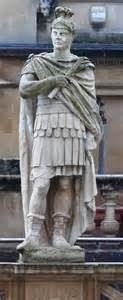
37 Gnaeus Julius Agricola was born. He was a Roman general noted for conquering all of England and part of Scotland (77-84).
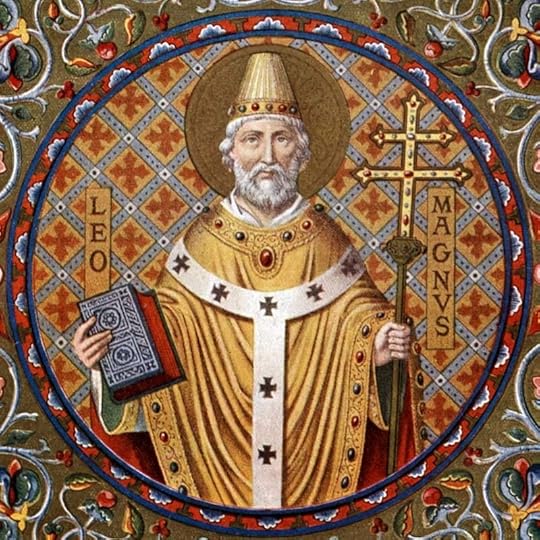
49 Pope Leo I, The Great, presented his Tome, affirming the reality of the two natures of Christ human and divine to Flavian, the Bishop of Constantinople.

313 The 'Edict of Milan' was proclaimed, ending the persecution of Christians across the Roman Empire.
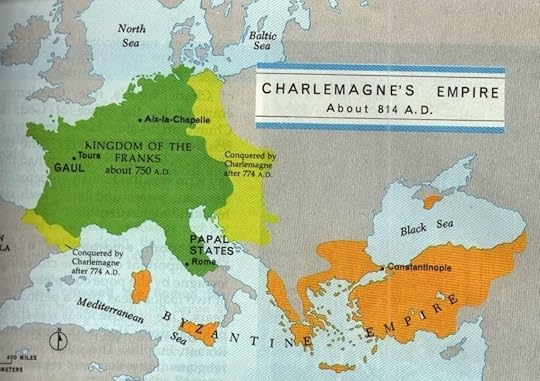
823 Charles I (the Bald) was born. He was the Grandson of Charlemagne who with his two half brothers divided Charlemagne's empire into three parts, with Charles becoming the first king of France (843-877).
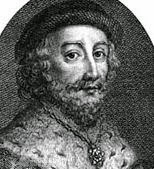
1249 Coronation of Alexander III as King of Scots.


37 Gnaeus Julius Agricola was born. He was a Roman general noted for conquering all of England and part of Scotland (77-84).

49 Pope Leo I, The Great, presented his Tome, affirming the reality of the two natures of Christ human and divine to Flavian, the Bishop of Constantinople.

313 The 'Edict of Milan' was proclaimed, ending the persecution of Christians across the Roman Empire.

823 Charles I (the Bald) was born. He was the Grandson of Charlemagne who with his two half brothers divided Charlemagne's empire into three parts, with Charles becoming the first king of France (843-877).

1249 Coronation of Alexander III as King of Scots.

Published on June 13, 2014 04:33
June 12, 2014
Indies Unlimited Featured Book, The Briton and the Dane: Timeline
 Featured Book, The Briton and the Dane: TimelinePosted on June 12, 2014 by Administrators
Featured Book, The Briton and the Dane: TimelinePosted on June 12, 2014 by Administrators 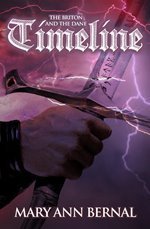 The Briton and the Dane: Timeline
The Briton and the Dane: Timelineby Mary Ann Bernal
Genres: romance, historical fiction
Available from Amazon.
A beautiful archeologist besotted with an Anglo-Saxon nobleman is transported back to eleventh century England where treachery abounds. She is determined to learn the identities of the treacherous blackguards hiding in the shadows, but will she walk away or intervene, thereby changing the course of history to save the man she loves?
http://www.indiesunlimited.com/2014/06/12/featured-book-timeline/

Published on June 12, 2014 15:58
Ancient Mayan Altars, Sculpted Artwork Discovered in Guatemala
By Owen Jarus
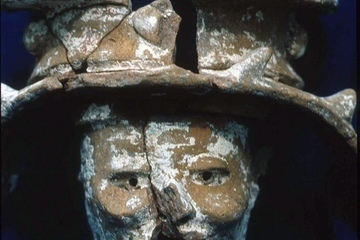
 This incense burner, showing the head of Itzamna, a deity who was the shaman of the Mayan gods, was discovered at a Mayan council house in Petén, Guatamela.
This incense burner, showing the head of Itzamna, a deity who was the shaman of the Mayan gods, was discovered at a Mayan council house in Petén, Guatamela.
Credit: Photo by Don Rice
A team of archaeologists in Guatemala has discovered a council house dating back about 700 years with altars, incense burners and sculpted images of animals.
Located at the site of Nixtun-Ch'ich' in Petén, Guatemala, the house has "two colonnaded halls constructed side by side. The halls were decorated with sculpted [reptile], parrot and turtle imagery," writes Timothy Pugh, a professor at Queens College in New York, in a summary of a talk he recently gave at the Society for American Archaeology annual meeting in Austin, Texas.
A Mayan group called the Chakan Itza would have used this council house as aplace to hold meetings, worship gods, make alliances and officiate marriage ceremonies.
"Basically almost every political and religious ritual would have been held there," Pugh told Live Science in an interview. The leaders who gathered there would have held power in the community and perhaps the broader region. Among the artifacts is an incense burner showing the head of Itzamna, who was the "shaman of the gods," Pugh said.
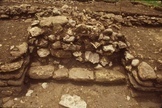
[image error] The Maya council house had two altars, each of which originally had a sculpted turtle on it.
The Maya council house had two altars, each of which originally had a sculpted turtle on it.
Credit: Photo by Timothy Pugh
View full size imageThe reptile and parrot sculptures once adorned the walls of the hallways, while two altars each had a sculpted turtle on them, Pugh said. Among the incense burners are examples that appear to be shaped like a seedling ceiba tree, which held importance to the Maya and today is the national tree of Guatemala.
Center of a community
The council house at Nixtun-Ch'ich', about 50 by 50 meters (164 by 164 feet), would have been part of a flourishing settlement. Archaeologists in previous expeditions found a giant ball court at the site, the second largest from the Mayan world, Pugh said. The largest Mayan ball court is at Chichen Itza, a city the Chaken Itza believed their ancestors had migrated from, Pugh said.
The council house appears to have been in use between about A.D. 1300 and 1500, Pugh said, adding that it could have been in use for some time after 1500. Around that time, Pugh believes, the Chakan Itza decided to destroy the council house and move the seat of power — something they would likely do on a regular basis.
"The Maya paid close attention to time and calendars," Pugh said. "After a certain cycle of time they would move the ruling seat to a new location."
In order to destroy the council house, "they basically conducted a ritual that cancelled out the power of this space," Pugh said. "They destroyed the altars and they covered the building" with a large amount of dirt, he said.
A living legacy
The Spanish would conquer the Peténregion of Guatemala by the end of the 17th century. The Itza people suffered many casualties from the conquest and European diseases to which they lacked immunity.
However the Itza, along with other Mayan people, persevered and continue to live on today. Many of the Itza now speak Spanish, although the Itza language is still spoken by a small number of individuals.
The research was funded by the National Science Foundation.
http://www.livescience.com/46215-ancient-mayan-artwork-discovered.html

 This incense burner, showing the head of Itzamna, a deity who was the shaman of the Mayan gods, was discovered at a Mayan council house in Petén, Guatamela.
This incense burner, showing the head of Itzamna, a deity who was the shaman of the Mayan gods, was discovered at a Mayan council house in Petén, Guatamela.Credit: Photo by Don Rice
A team of archaeologists in Guatemala has discovered a council house dating back about 700 years with altars, incense burners and sculpted images of animals.
Located at the site of Nixtun-Ch'ich' in Petén, Guatemala, the house has "two colonnaded halls constructed side by side. The halls were decorated with sculpted [reptile], parrot and turtle imagery," writes Timothy Pugh, a professor at Queens College in New York, in a summary of a talk he recently gave at the Society for American Archaeology annual meeting in Austin, Texas.
A Mayan group called the Chakan Itza would have used this council house as aplace to hold meetings, worship gods, make alliances and officiate marriage ceremonies.
"Basically almost every political and religious ritual would have been held there," Pugh told Live Science in an interview. The leaders who gathered there would have held power in the community and perhaps the broader region. Among the artifacts is an incense burner showing the head of Itzamna, who was the "shaman of the gods," Pugh said.

[image error]
 The Maya council house had two altars, each of which originally had a sculpted turtle on it.
The Maya council house had two altars, each of which originally had a sculpted turtle on it.Credit: Photo by Timothy Pugh
View full size imageThe reptile and parrot sculptures once adorned the walls of the hallways, while two altars each had a sculpted turtle on them, Pugh said. Among the incense burners are examples that appear to be shaped like a seedling ceiba tree, which held importance to the Maya and today is the national tree of Guatemala.
Center of a community
The council house at Nixtun-Ch'ich', about 50 by 50 meters (164 by 164 feet), would have been part of a flourishing settlement. Archaeologists in previous expeditions found a giant ball court at the site, the second largest from the Mayan world, Pugh said. The largest Mayan ball court is at Chichen Itza, a city the Chaken Itza believed their ancestors had migrated from, Pugh said.
The council house appears to have been in use between about A.D. 1300 and 1500, Pugh said, adding that it could have been in use for some time after 1500. Around that time, Pugh believes, the Chakan Itza decided to destroy the council house and move the seat of power — something they would likely do on a regular basis.
"The Maya paid close attention to time and calendars," Pugh said. "After a certain cycle of time they would move the ruling seat to a new location."
In order to destroy the council house, "they basically conducted a ritual that cancelled out the power of this space," Pugh said. "They destroyed the altars and they covered the building" with a large amount of dirt, he said.
A living legacy
The Spanish would conquer the Peténregion of Guatemala by the end of the 17th century. The Itza people suffered many casualties from the conquest and European diseases to which they lacked immunity.
However the Itza, along with other Mayan people, persevered and continue to live on today. Many of the Itza now speak Spanish, although the Itza language is still spoken by a small number of individuals.
The research was funded by the National Science Foundation.
http://www.livescience.com/46215-ancient-mayan-artwork-discovered.html

Published on June 12, 2014 11:34
3000-Year-Old Remains of Baby Found at Halloween's Birthplace
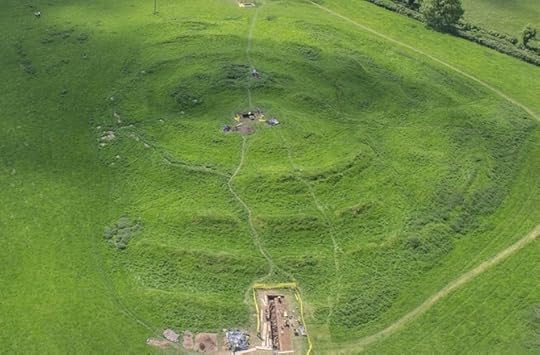 by Rossella Lorenzi Remains of a baby dating back to 3,000 years ago have been found at a site in Ireland that is believed to be the birthplace of Halloween.
by Rossella Lorenzi Remains of a baby dating back to 3,000 years ago have been found at a site in Ireland that is believed to be the birthplace of Halloween.The fully intact skeleton, possibly belonging to a 7-10 month child, was unearthed during a three week excavation at Tlachtga, on the Hill of Ward near Athboy Co. Meath.
One of Ireland’s most enigmatic sites, the Hill of Tlachtga features impressive circular earthworks which are best seen from the air. Medieval texts link the site to Samhain, the ancient Celtic Festival which is the precursor to modern Halloween.
Why Do We Connect Halloween and Satanism?
“We may never know what caused the death of the child. The skeleton probably dates back 3,000 years and was found on the bedrock at the base of a 1.5m (3-foot, 28-inch) ditch,” lead archaeologist Stephen Davis, at University College Dublin, told the Irish Examiner.
Excavation and surveys carried out using airborne laser revealed the area was a “key ritual site.”
“The site has several different phases of monumental enclosures and we believe them to be associated with festivals and rituals potentially dating back as far as 1,000 B.C.,” Davis said.
Sitting on top of the Hill of Ward, Tlachtga is a site steeped in folklore. According to Irish mythology, it got its name from the daughter of the powerful druid Mug Ruith. According to legend, the remains of the druidess, who is said to have died on the hill after giving birth to triplets, are buried there.
Tlachtga is also believed to be the site of the Great Fire Festival in which sacrifices were offered to gods on Samhain eve. All hearth fires throughout Ireland were extinguished and then lit again from a central fire on the hill.
Video: Where Did Halloween Come From?
Meaning summer’s end, Samhain was a great festival of the dead — a time when the doorways to the otherworld opened and journeys could be made from one side to the other.
The veil between the worlds of the living and the dead was believed to be the thinnest on Oct. 31, a day which lies exactly between the autumnal equinox and the winter solstice.
The excavation revealed the monument of Tlachtga is actually the last of at least three phases of enclosure on the hill.
“As a working model for the phases of construction, at least one small enclosure, about 15 inches in diameter, was enclosed by a very large, tri- or quadrivallate enclosure, about 650 feet in diameter, which was replaced by the monument we see today,” the archaeologists said.
Large Meteorite Likely Found in Druid Burial Site
The excavations also brought to light evidence of burning, which could have been ritual fires or the result of glass-making, Davis said.
He believes the child was most likely not the victim of any human sacrifice on the ritual site.
The remains have been taken to the School of Archaeology at University College Dublin for further examination.http://news.discovery.com/history/archaeology/3000-year-old-remains-of-baby-found-at-halloweens-birthplace-140610.htm

Published on June 12, 2014 11:27




